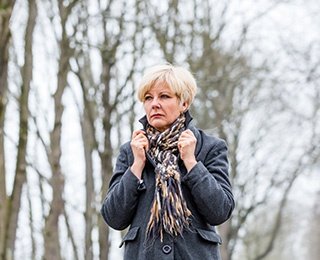Your arms and legs feel leaden. You feel like you never get enough sleep. You crave chowder and Boston cream pie. That’s just the usual results of a New England winter, right? Yes. Is it depression? Possibly. Northern (and far southern climates) experience shorter days during winter. Those shorter days can cause depression to worsen. Lack of light also causes mild depression (also called the winter blues) and seasonal affective disorder (SAD). All three are forms of depression, with the accompanying symptoms:
- depressed mood
- feelings of hopelessness
- lack of energy
- difficulty concentrating
- changes in sleep and appetite
- loss of pleasure in activities you once loved
- thoughts of death or suicide
Could your parent have depression without these symptoms? Note these unusual warning signs of depression.
How can you tell if it’s SAD?
People who experience the winter form of SAD frequently have symptoms in addition to those of depression, such as heaviness in arms and legs, frequent oversleeping, cravings for carbohydrates/weight gain, and relationship problems. The most prevalent form of Seasonal Affective Disorder only occurs during the late fall/winter, when the amount of natural light in regions farther from the equator begins to decline.
How common is SAD?
About 4 to 6% of people in the United States have been diagnosed with SAD. Researchers report another 10 to 20% may experience a mild form of winter SAD.
Who is at risk for SAD?
Women and people who live farther from the equator are most at risk for SAD. People who live farther from the equator are also at risk for the “winter blues”. Older people frequently dismiss SAD, because they’ve experienced symptoms so often, they believe it’s normal. As a result, they may not seek help.
SAD and older adults
Some will insist that SAD rarely affects older adults, but the truth is that older adults rarely report depression. They may fail to report symptoms of depression, because older people tend to be uncomplaining or because they’re accustomed to feeling out of sorts during the winter months. Many older people focus on physical disease and believe depression is not a real illness. General practice physicians, too, have little training in the diagnosis and treatment of elders. The healthcare provider simply may not recognize the symptoms. The symptoms of depression are similar to those of other illnesses and medication side effects. This makes it even more difficult to diagnose older adults, who tend to have chronic illnesses and use medication. Any type of depression, whether SAD, clinical depression, or the winter blues, increases the risk of cardiac diseases in the older population. Depression also increases the risk of death from other illnesses, because it makes rehabilitation more difficult. Among older white males, depression increases the risk of suicide. The suicide rate among adults ages 65 to 85 was 19.4% in 2015, second only to the 19.6% suicide rate among adults between 45 and 64.
Treatment for SAD
The treatment for SAD is the same as for any form of depression: Consult a doctor immediately. Although many self-help articles advocate getting out into the sunshine or using light therapy, professionals advise seeking treatment from a healthcare provider if depressive symptoms occur for a two-week period or longer. SAD is difficult to diagnose. Not only may it be confused with other forms of depression, similar symptoms may be caused by medication or illness. Only a healthcare professional can make a proper diagnosis. Mental health professionals can also offer a range of options that include medication, light therapy, and cognitive-behavioral talk therapy. Your healthcare team can also monitor symptoms and change treatment if one is ineffective.
Prevention is best
At The Arbors Assisted Living, we believe in creating an engaging, stimulating environment that benefits the mind, body and spirit of our residents. We promote a lifestyle of health and wellness, with programs that benefit brain health, physical fitness and more.

